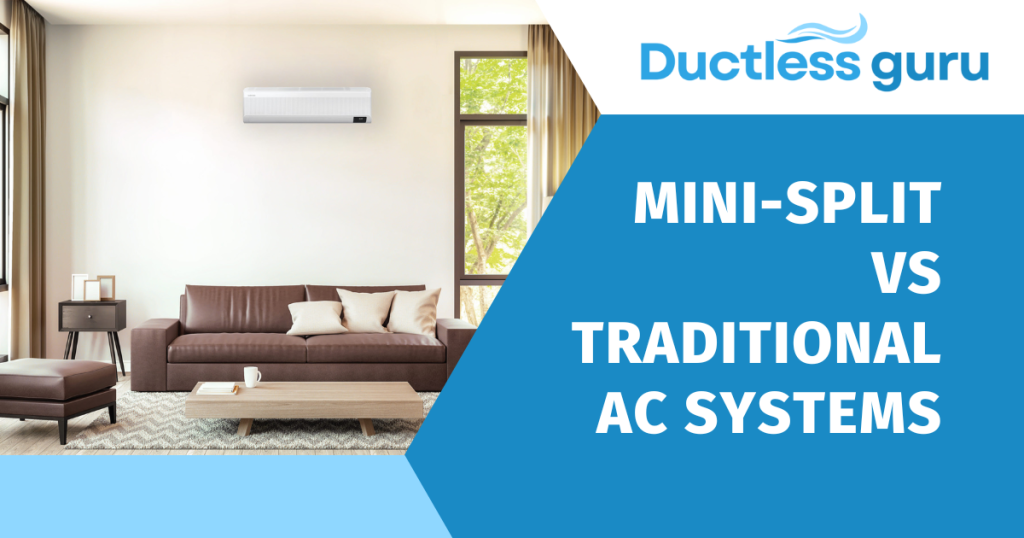
When it comes to cooling your home, the debate between mini-split systems and traditional air conditioning systems is a common one. Each system has its own set of advantages and disadvantages, and understanding these can help you make an informed decision. In this article, we will explore the key differences between mini-split systems and traditional air conditioning systems, focusing on aspects such as installation, efficiency, cost, and maintenance.
Understanding Mini-Split Systems
Mini-split systems, also known as ductless air conditioners, consist of an outdoor compressor unit and one or more indoor air-handling units. These systems are called “ductless” because they don’t require the network of ducts used by traditional HVAC systems. Instead, they deliver cooled or heated air directly into different zones or rooms of your home.
Advantages of Mini-Split Systems
- Energy Efficiency: One of the main benefits of mini-split systems is their energy efficiency. Without the need for ducts, which can lose up to 30% of energy due to leaks and poor insulation, mini-splits provide efficient cooling and heating. Additionally, many mini-split units use inverter technology to adjust the compressor speed, reducing energy consumption.
- Zoned Cooling and Heating: Mini-split systems allow for zoned cooling and heating, meaning you can control the temperature of individual rooms or areas. This personalized control can lead to significant energy savings, as you can cool only the spaces in use.
- Ease of Installation: Installing a mini-split system is generally less invasive and quicker than installing a traditional system. Since there are no ducts to install, the process involves mounting the indoor units and connecting them to the outdoor unit through a small conduit.
- Flexibility: These systems are highly versatile and can be installed in various types of buildings, including homes, offices, and additions. They are particularly useful in spaces where installing ductwork would be challenging or impractical.
Disadvantages of Mini-Split Systems
- Initial Cost: The upfront cost of mini-split systems can be higher than that of traditional systems. However, the energy savings over time often offset this initial expense.
- Aesthetics: Some homeowners may find the appearance of the indoor air-handling units unappealing, as they are more visible compared to the discreet vents of ducted systems.
Understanding Traditional Air Conditioning Systems
Traditional air conditioning systems, also known as central air conditioning, use a network of ducts to distribute cooled air throughout the home. These systems consist of an outdoor unit, an indoor unit, and a system of ducts that deliver air to various rooms.
Advantages of Traditional Air Conditioning Systems
- Uniform Cooling: Traditional systems provide uniform cooling throughout the entire home, which can be beneficial for larger spaces. This ensures that all rooms maintain a consistent temperature.
- Aesthetic Appeal: Central air conditioning systems have a more discreet appearance, with the air being delivered through vents in the ceiling, floor, or walls. This can be more aesthetically pleasing for some homeowners.
- Lower Initial Cost: The initial cost of installing a traditional air conditioning system can be lower than that of a mini-split system, especially in new constructions where ductwork is already planned.
Disadvantages of Traditional Air Conditioning Systems
- Energy Loss: Ducted systems are prone to energy losses through leaks, poor insulation, and inefficient design. This can lead to higher energy consumption and increased utility bills.
- Maintenance: Maintaining a central air system can be more complicated and costly, as it involves regular duct cleaning and inspections to ensure efficient operation.
- Lack of Zoning: Traditional systems often lack the ability to provide zoned cooling. As a result, energy is wasted cooling rooms that are not in use.
Comparing Mini-Splits and Traditional Systems
To make an informed decision, it’s essential to compare mini-split and traditional systems across several key factors:
1. Installation
- Mini-Splits: Easier and quicker to install, with less disruption to your home. Ideal for retrofitting older homes without existing ductwork.
- Traditional Systems: Installation can be more invasive and time-consuming, especially if ducts need to be added or modified.
2. Energy Efficiency
- Mini-Splits: Generally more energy-efficient due to the lack of ductwork and advanced technologies like inverter-driven compressors.
- Traditional Systems: Can be less efficient due to potential energy losses in ductwork.
3. Cost
- Mini-Splits: Higher initial cost, but potential for significant energy savings over time.
- Traditional Systems: Lower initial cost, but potentially higher long-term energy costs due to inefficiencies.
4. Maintenance
- Mini-Splits: Easier to maintain, with simple filter cleaning and periodic professional inspections.
- Traditional Systems: More complex maintenance, including regular duct cleaning and more extensive servicing.
5. Comfort and Control
- Mini-Splits: Offer zoned cooling and heating, allowing for personalized comfort in different rooms.
- Traditional Systems: Provide uniform cooling but lack individual room control without additional zoning systems.
Conclusion
Both mini-split and traditional air conditioning systems have their merits and are suited for different needs and preferences. Mini-splits are ideal for homeowners seeking energy efficiency, ease of installation, and zoned cooling. On the other hand, traditional systems may be more suitable for those who prefer uniform cooling and a more discreet appearance.
When choosing between the two, consider factors such as your home’s layout, budget, energy efficiency goals, and personal comfort preferences. By weighing the pros and cons, you can select the cooling system that best meets your needs, ensuring comfort and efficiency for years to come.
